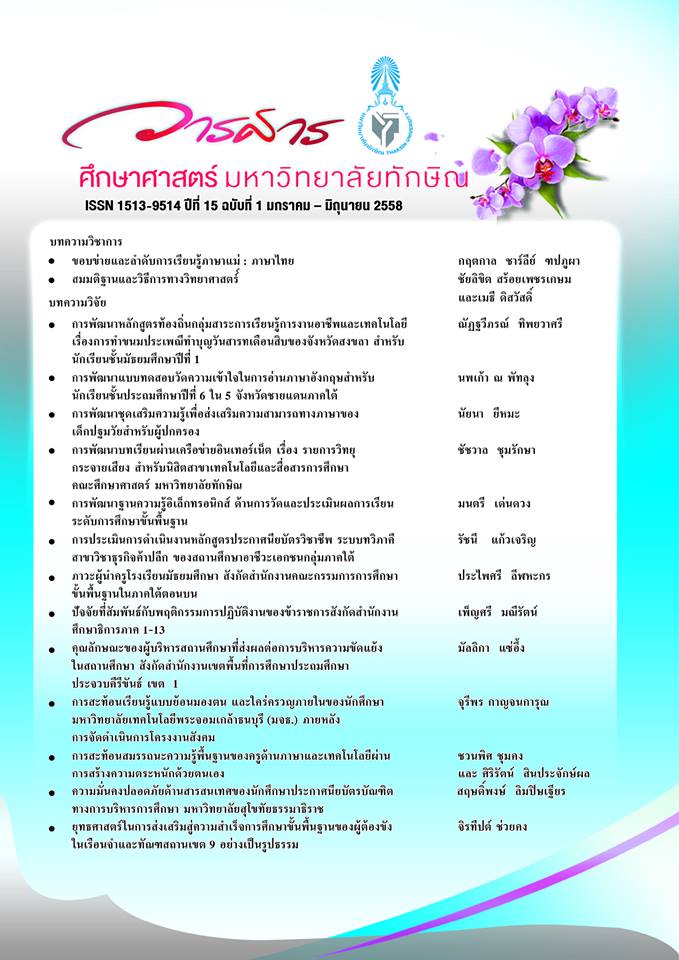ภาวะผู้นำครูโรงเรียนมัธยมศึกษา สังกัดสำนักงานคณะกรรมการการศึกษาขั้นพื้นฐานในภาคใต้ตอนบน
Main Article Content
บทคัดย่อ
การวิจัยครั้งนี้มีวัตถุประสงค์ เพื่อวิเคราะห์องค์ประกอบภาวะผู้นำครู ศึกษาความสัมพันธ์ระหว่างภาวะผู้นำครูกับคุณภาพการศึกษาของนักเรียน และนำเสนอแนวทางการพัฒนาภาวะผู้นำครู การดำเนินการวิจัย แบ่งเป็น 3 ระยะ ระยะที่ 1 เป็นการวิเคราะห์องค์ประกอบภาวะผู้นำครูโดยเก็บรวบรวมข้อมูลจากครูโรงเรียนมัธยมศึกษา สังกัดสำนักงานคณะกรรมการการศึกษาขั้นพื้นฐาน ในภาคใต้ตอนบน จำนวน 920 คน และนำข้อมูลที่ได้มาวิเคราะห์องค์ประกอบเชิงสำรวจ (Exploratory Factor Analysis) ระยะที่ 2 นำองค์ประกอบภาวะผู้นำครูที่ได้ไปศึกษาความสัมพันธ์กับคุณภาพการศึกษาของนักเรียนที่เป็นผลสัมฤทธิ์ทางการเรียนในตัวบ่งชี้ที่ 5 ซึ่งเป็นผลการประเมินภายนอกรอบสามของ สมศ. และระยะที่ 3 เป็นการนำเสนอแนวทางการพัฒนาภาวะผู้นำครูที่ผ่านการพิจารณาความเหมาะสมและความเป็นไปได้จากผู้ทรงคุณวุฒิ จำนวน 19 คน
ผลการวิจัยพบว่า องค์ประกอบภาวะผู้นำครูโรงเรียนมัธยมศึกษา สังกัดสำนักงานคณะกรรมการการศึกษาขั้นพื้นฐาน ในภาคใต้ตอนบน ประกอบด้วย 7 องค์ประกอบ ได้แก่ 1) การตัดสินใจร่วมกันในการพัฒนาคุณภาพการศึกษาในโรงเรียน 2) การสร้างความสัมพันธ์ร่วมกันที่จะพัฒนาการเรียนรู้ของนักเรียน 3) การร่วมกันพัฒนาการเรียนการสอนให้บรรลุเป้าหมาย 4) การแลกเปลี่ยนเรียนรู้ร่วมกัน 5) การมีอิทธิพลต่อผู้อื่นในการทำงานของโรงเรียน 6) การมีความรู้ความสามารถในการเรียนการสอนนักเรียน และ 7) การมีภาวะผู้นำในการทำงาน โดยภาวะผู้นำครูกับคุณภาพการศึกษาของนักเรียน ในภาพรวมมีความสัมพันธ์ทางบวกในระดับสูงมาก (r = .884)
อย่างมีนัยสำคัญทางสถิติที่ระดับ .01 สำหรับแนวทางการพัฒนาภาวะผู้นำครูที่ได้พัฒนาขึ้นนั้น ประกอบด้วย 4 ส่วน คือ ส่วนที่ 1 แนวคิด ทฤษฎีภาวะผู้นำครู ส่วนที่ 2 องค์ประกอบภาวะผู้นำครู ส่วนที่ 3 กระบวนการพัฒนาภาวะผู้นำครู มี 4 ขั้นย่อย ได้แก่ ขั้นที่ 1 เตรียมความพร้อมในการพัฒนา ขั้นที่ 2 ประเมินก่อนการพัฒนา ขั้นที่ 3 พัฒนาภาวะผู้นำครู และขั้นที่ 4 ประเมินหลังการพัฒนา และส่วนที่ 4 การนำแนวทางไปใช้
Teacher Leadership in Secondary Schools under The Office of The Basic Education Commission in Upper Southern Region
Prapaisri Leelahakorn1, Chusak Ekpetch2 and Bunjong Charurnsuk3
The objectives of this research were: to analyze the elements of teacher leadership; to study the relationship between teacher leadership and quality of student education; and to introduce the guidelines for teacher leadership development. The research procedures were divided into 3 phases. Phase 1 was used to analyze the elements of teacher leadership. Data were collected from 920 teachers in secondary schools under Office of The Basic Education Commission in Upper Southern Region and analyzed for the exploratory factors. Phase 2 was used to study the relationship between elements of teacher leadership and quality of student education regarding the learning achievement from 5th indicator, which derived from the 3rd round external evaluation of The Office for National Education Standards and Quality Assessment (Public Organization). Phase 3 was used to suggest the guidelines of teacher leadership development. Data were collected from 19 experts and analyzed for the appropriateness and feasibility.
The research results showed that the elements of teacher leadership in secondary schools under The Office of The Basic Education Commission in Upper Southern Region consisted of 7 elements: 1) Collaborative decision making on development of education in schools; 2) Collaborative creation of cooperation developing the learning of students; 3) Collaborative instructional development for goal achievement; 4) Collaborative knowledge sharing; 5) Influential person in school works; 6) Specialization in teaching students; and 7) Leadership in working. In addition, the relationship between teacher leadership and quality of student education showed a high positive correlation (r = .884) at statistical significance level of .01. The developed guidelines for teacher leadership development consisted of 4 parts; Part 1 referred to the rationales and teacher leadership theories; Part 2 referred to the elements of teacher leadership; Part 3 referred to the process of teacher leadership development, which consisted of 4 steps: Step 1 referred to the development preparation; Step 2 referred to the development pre-assessment; Step 3 referred to the teacher leadership development; and Step 4 referred to the development post-assessment; and Part 4 referred to the guidelines implementation.
Article Details
ในกรณีที่กองบรรณาธิการ หรือผู้เชี่ยวชาญ ซึ่งได้รับเชิญให้เป็นผู้ตรวจบทความวิจัย หรือ บทความทางวิชาการมีความเห็นว่าควรแก้ไขความบกพร่อง ทางกองบรรณาธิการจะส่งต้นฉบับให้ ผู้เขียนพิจารณาจัดการแก้ไขให้เหมาะสมก่อนที่จะลงพิมพ์ ทั้งนี้ กองบรรณาธิการจะยึดถือความคิด เห็นของผู้เชี่ยวชาญเป็นเกณฑ์


